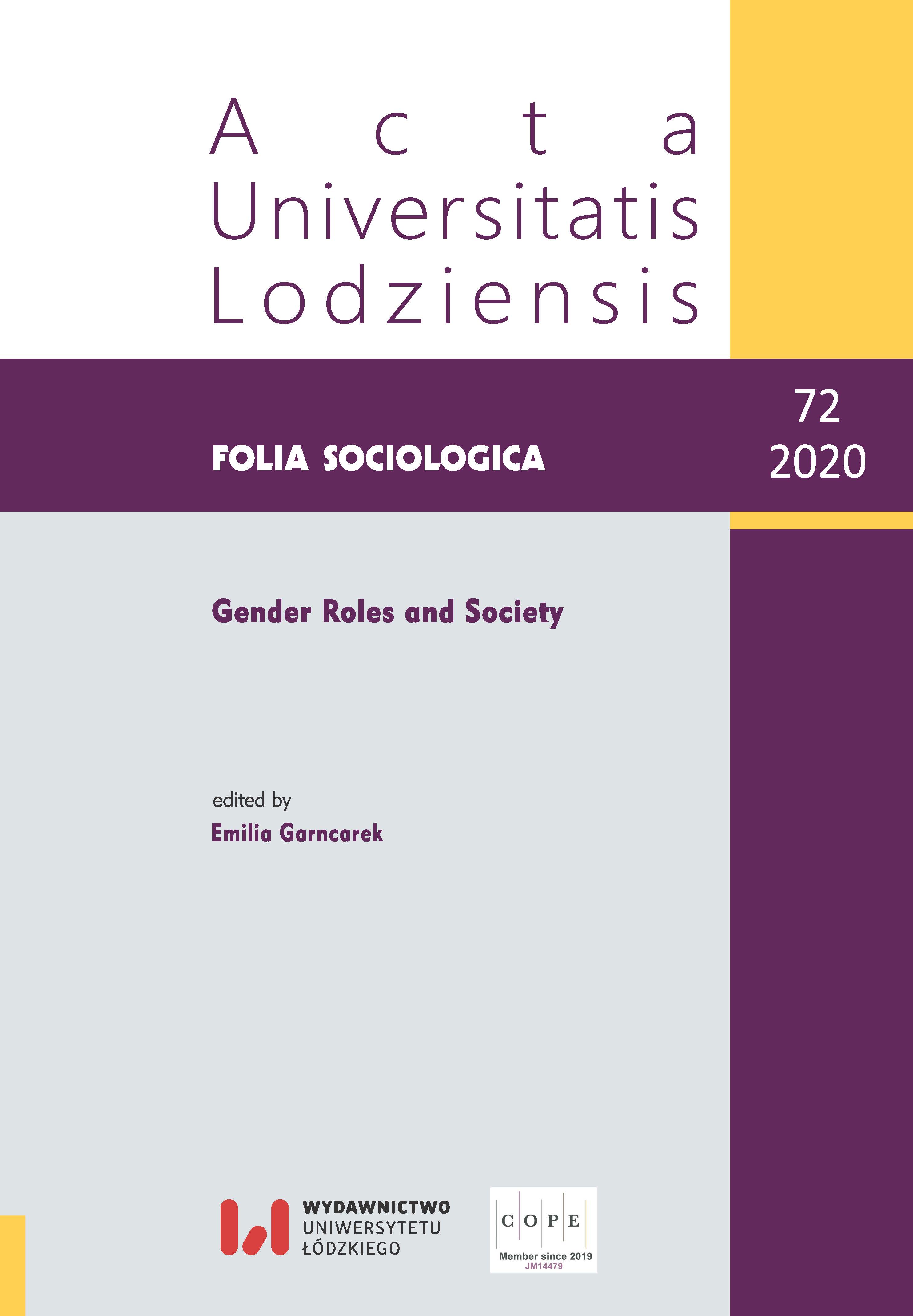Senior citizens’ clothing in a “youthing” polish society. The perspective of elderly women and men
DOI:
https://doi.org/10.18778/0208-600X.72.03Keywords:
clothing, seniors, senior citizens, the age-ordering of clothes, Polish People’s Republic, “youthing” societyAbstract
The way the modern-day senior citizens dress may be determined by their functioning in a “youthing” society, together with the legacy of the Polish People’s Republic and the dress codes prevailing at that time. This article provides an analysis of the abovementioned issue in a gender context, as the described age-ordering of clothes in this text concerns women and men differently. The analysis was based on a diagnostic survey, conducted among people over sixty years old, who gave their opinions on their own and their peers’ dress sense.
The responses given suggest that the trends characteristic for a “youthing” society contribute to rejuvenating the way Polish senior citizens dress. According to them, the elderly dress fashionably, tastefully and colorfully – which was stated more often by the women than the men. The survey results also confirm that the dress codes relevant to PPR times are deeply rooted in the seniors’ minds. This was reflected more often in men’s opinions than in women’s.
The preliminary results presented in this article indicate that the way elderly people in Poland dress is beginning to be reshaped. The results require greater depth, and this could be facilitated through the use of qualitative techniques that might complement the collected material.
References
Barnard M. (1996), Fashion as Communication, Routledge, London.
Google Scholar
Bokszańska G. (2004), Ubiór w teatrze życia społecznego, Wydawnictwo Politechniki Łódzkiej, Łódź.
Google Scholar
Bordo S. (2003), Unbearable Weight. Feminism, Western Culture and the Body, University of California Press, Berkeley California.
Google Scholar
Bylok F. (2013), Strategie zachowań konsumenckich seniorów na rynku dóbr i usług konsumenckich, “Problemy Zarządzania”, no. 11/1(1), pp. 123–142.
Google Scholar
Chmielińska A. (2014), Moda – między konformizmem a przekraczaniem granic (w świetle koncepcji Georga Simmla), [in:] W. Bobrowicz, D. Kubinowski, Z. Pakuła (eds.), Moda w kulturze, sztuce i edukacji, Wydawnictwo Uniwersytetu Marii Curie-Skłodowskiej, Lublin, pp. 67–78.
Google Scholar
Czekalski T. (2008), Czasy współczesne, [in:] A. Chwalba (ed.), Obyczaje w Polsce. Od średniowiecza do czasów współczesnych, Wydawnictwo Naukowe PWN, Warszawa, pp. 340–424.
Google Scholar
de Beauvoir S. (2003), Druga płeć, Wydawnictwo Czarna Owca, Warszawa.
Google Scholar
Gibson P. (2000), “No One Expects Me Anywhere”: Invisible Women, Ageing and the Fashion Industry, [in:] S. Bruzzi, P.Ch. Gibson (eds.), Fashion Cultures: Theories, Explorations and Analysis, Routledge, London, pp. 79–90.
Google Scholar
Giddens A. (2009), Europa w epoce globalnej, Wydawnictwo Naukowe PWN, Warszawa.
Google Scholar
Gilleard C., Higgs P. (2000), Culture of Ageing: Self, Citizen and the Body, Prentice Hall, London.
Google Scholar
Główny Urząd Statystyczny (2019), Informacja o sytuacji osób starszych na podstawie badań Głównego Urzędu Statystycznego, Warszawa, https://stat.gov.pl/obszarytematyczne/osobystarsze/osoby-starsze/informacja-o-sytuacji-osob-starszych-na-podstawie-badan-glownegourzedustatystycznego,1,1.html (accessed 4.08.2019).
Google Scholar
Grajewska A. (2008), Hasło: feminizm, Wydawnictwo Poznańskie, Poznań.
Google Scholar
Greer G. (1991), The Change: Women, Ageing and the Menopause, Hamish Hamilton, London.
Google Scholar
Gromkowska-Melosik A. (2012), Ciało, moda i tożsamość kobiety epoki wiktoriańskiej – dyskursy piękna i przemocy, “Kultura − Społeczeństwo – Edukacja”, no. 2, pp. 17–30.
Google Scholar
Gromkowska-Melosik A. (2013), Kobieta epoki wiktoriańskiej. Tożsamość, ciało i medykalizacja, Oficyna Wydawnicza “Impuls”, Kraków.
Google Scholar
Jacobson D., http://www.seniorstylebible.com (accessed 2.08.2019).
Google Scholar
Jeffreis S. (2005), Beauty and Misogyny: Harmful Cultural Practies in the West, Routledge, London.
Google Scholar
Kolibabska K. (2009), Trwanie w młodości. Strategie odmładzające stosowane przez ludzi starszych z warszawskiego centrum usług socjalnych, [in:] H. Jakubowska, A. Raciniewska, Ł. Rogowski (eds.), Patrząc na starość, Wydawnictwo Naukowe Uniwersytetu im. Adama Mickiewicza, Poznań, pp. 49–63.
Google Scholar
Konieczna-Woźniak R. (2012), “Odmłodzona” starość – implikacje podmiotowe i społecznej, “Studia Edukacyjne”, no. 2, pp. 249–262.
Google Scholar
Łaciak B. (2006), Obyczaje dotyczące ciała w Polsce okresu transformacji, [in:] J. Kurczewski, B. Łaciak, A. Herman, D. Dzido, A. Suflida, Praktyki cielesne, Wydawnictwo “Trio”, Warszawa, pp. 69–111.
Google Scholar
Pawlikowska K. (2014), Modne Polki, czyli prawie każda zna się na trendach, [in:] K. Pawlikowska, D. Maison (eds.), Polki. Spełnione profesjonalistki, rodzinne panie domu czy obywatelki świata, Wydawnictwo Uniwersytetu Warszawskiego, Warszawa, pp. 124–144.
Google Scholar
Slevin K.F. (2010), “If I had lots of money… I’d have a body makeover”: Managing the Aging Body, “Social Forces”, no. 88(3), pp. 1003–1020.
Google Scholar
Szarota P. (2008), Od skarpetek Tyrmanda do krawata Leppera. Psychologia stroju dla średnio zaawansowanych, Wydawnictwa Akademickie i Profesjonalne, Warszawa.
Google Scholar
Szczepański M.S., Pawlica B., Śliz A., Zarębska-Mazan A. (eds.) (2008), Ciało spieniężone? Szkice antropologiczne i socjologiczne, Śląskie Wydawnictwa Naukowe, Tychy–Opole.
Google Scholar
Toussaint-Samat M. (2011), Historia stroju, (transl.) K. Szeżyńska-Maćkowiak, Wydawnictwo W.A.B., Warszawa.
Google Scholar
Twigg J. (2007), Clothing, age and the body: a critical review, “Ageing&Society”, no. 27, pp. 285–305.
Google Scholar
Twigg J. (2013), Fashion and age. Dress, the Body and Later Life, Bloomsbury, London.
Google Scholar
DOI: https://doi.org/10.2752/9781474290340
Więch K. (2015), Si(l)ni mężczyźni? Aktualność stereotypu kobiety jako ofiary przemocy stosowanej przez mężczyzn, [in:] W. Jakimiuk-Sawczyńska (ed.), Metamorfozy kobiecości w życiu i w literaturze, Wydawnictwo Uniwersytetu w Białymstoku, Białystok, pp. 219–234.
Google Scholar
Williams D., Sołtysiak G. (2016), Modny PRL, Świat Książki, Warszawa.
Google Scholar
Downloads
Published
How to Cite
Issue
Section
License

This work is licensed under a Creative Commons Attribution-NonCommercial-NoDerivatives 4.0 International License.










